
Judge Rules Boaters Have “No Constitutional Right” to Anchor in Richardson Bay
In what has the potential to be a landmark case, a federal judge ruled late last year that boaters do not have a constitutional right to anchor on Richardson Bay, and declared that local agencies have the authority to create and enforce laws governing vessels anchored in their waters.
“To the extent [an anchor-out plaintiff] is alleging a stand-alone constitutional entitlement to anchor where he chooses, the United States’ constitution does not confer a blanket right to anchor in Richardson’s Bay,” federal judge William Orrick wrote in a December 2023 ruling, dismissing the claims of plaintiff Robert Roark, owner of the 60-ft motorsailer Kittiwake, who accused the Richardson Bay Regional Agency (RBRA) of violating his constitutional rights. Judge Orrick cited precedent in rejecting the argument that the special-anchorage designations conflict with local ordinances that require permits to stay beyond 72 hours.
The ruling appears to be another step toward the end of the anchor-out era on Richardson Bay. In the past seven years, increased enforcement has dramatically reduced the number of boats in Richardson Bay from over 300 vessels in 2016 to fewer than 50 today, with a large chunk of boats slated for removal in October.
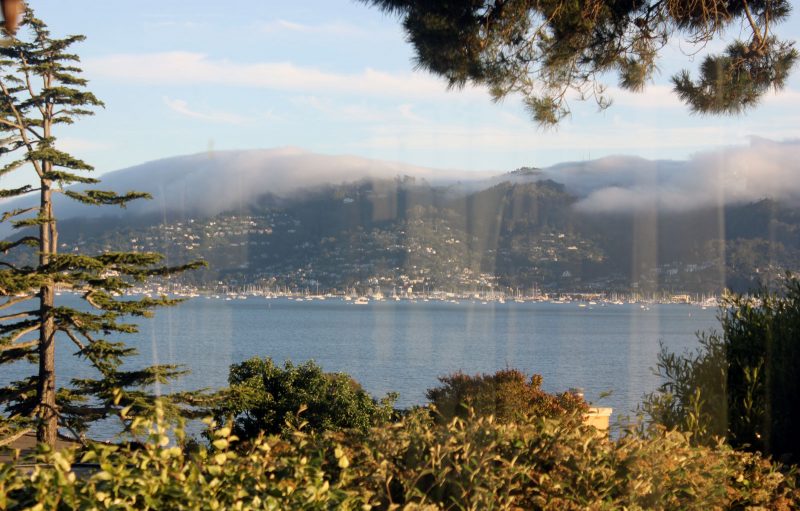
In a June 2021 post on his Facebook page, Robert Roark wrote that he’d filed for a temporary injunction against the RBRA while Kittiwake was at the Army Corps dock. Roark, who said that he had lived on his vessel for over 30 years, wrote that Kittiwake had been “ransacked and robbed and set adrift from China Camp,” after which the Coast Guard apparently towed the vessel to Sausalito. “Now it [has] turned into a lawsuit against the county of Marin and the RBRA. At the first zoom hearing, Judge Orrick told me that I have no constitutional right to anchor in the Bay.” (The recent ruling also mentioned that Roark was given a “notice to remove” in December 2022, though the exact timeline, details and ultimate fate of Kittiwake remain unclear. We reached out to Roark for comment but have not heard back.)
In his lawsuit — which named former harbormaster Curtis Havel and former RBRA executive directors Beth Pollard and Steve McGrath — Roark challenged the constitutionality of the RBRA’s “Anchoring Permit Scheme.” In his 31-page ruling, Judge Orrick cited two West Coast cases where it was ruled that local governments in San Diego and Hawaii did not exceed their jurisdictions in establishing anchoring and mooring regulations.
In the early ’90s case Graf v. San Diego Unified Port Dist., a federal judge ruled that “the jurisdiction to establish and enforce the anchorage and non-anchorage areas in San Diego Harbor is concurrent between the federal government and the local body delegated with authority … boaters do not have a constitutional right to unregulated long-term anchorage in public navigable waters.” In the 1994 case Barber v. State of HAWAI’I, another federal judge ruled that the “requirement vessels in excess of 65-ft anchored in Ke’ehi Lagoon must exhibit white lights [one of the main provisions of a special-anchorage area] while at anchor does not conflict with Hawaii’s regulations, which simply require that boats in the lagoon obtain a permit and moor in a designated area if the boat is to remain in the lagoon for more than 72 hours.”
Not mentioned in the December 2023 ruling was the 1989 case The Mariners of Richardson Bay vs. the RBRA, where a federal court dismissed a lawsuit challenging the RBRA’s ordinance No. 87-1, which “prohibits persons from anchoring a vessel for more than 72 hours without obtaining a permit from the harbormaster, [or] from living aboard an anchored or moored houseboat or vessel for more than 30 days.”
Speaking about Robert Roark’s recent claims, Judge Orrick wrote: “… No regulation or federal authority identified by Roark preempts the authority of RBRA to control anchorages in Richardson’s Bay. Instead, the federal regulations [Roark] identified establish Richardson’s Bay as a ‘special anchorage area’ and direct mariners to comply with the RBRA’s Permit Scheme.” (While the common spelling is “Richardson” Bay, the County of Marin, and apparently the US District Court in Northern California, call it “Richardson’s.”)
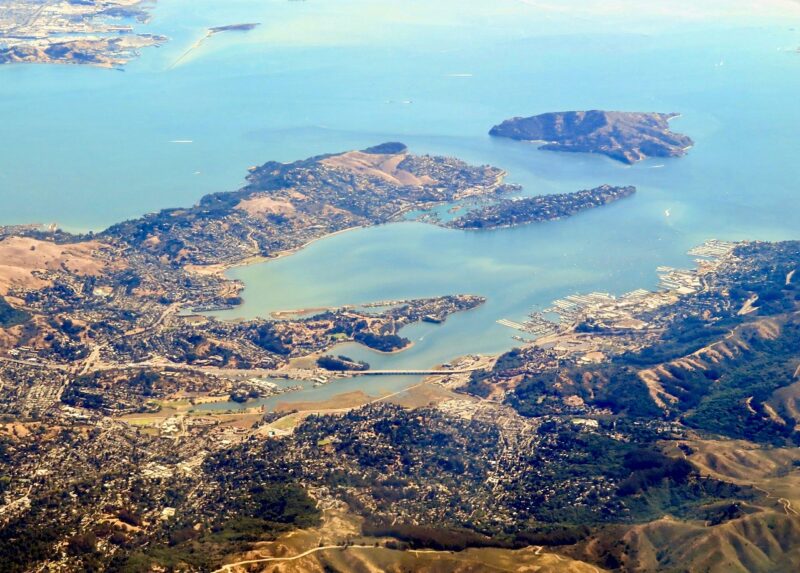
In early 2022, we reported that there were two lawsuits against the RBRA; one case alleged that former harbormaster Havel illegally seized and destroyed a 25-ft power boat, engine and skiff in November 2019. The status of that suit is unclear. “We do not discuss whether or not there is pending litigation,” RBRA executive director Brad Gross told Latitude yesterday in an email. “That said, Judge Orrick’s decision was a beneficial one for RBRA.”
As part of a 2021 agreement between the Bay Conservation and Development Commission (BCDC) and the RBRA, a mooring field was supposed to be installed in Richardson Bay. That “remains on hold with no discussion on resurrecting any time soon,” Gross told us. In 2022, the SF Bay Stewardship Alliance said in a press release that “RBRA has cancelled the contract it had approved in February 2022 for the mooring-field project and will use those funds for its vessel buyback program.” Latitude 38 has long called for some kind of moorings for daysailers and transient cruisers, but it appears that Richardson Bay is destined to remain relatively empty. (Anchoring will presumably be available on the 72-hour program.)
“There are two removal deadlines we are now working on,” Gross added in his email. “Thirty-five must vacate by 10/15/24, and 7 vessels who are in the Safe and Seaworthy program must relocate by 10/15/26.”
Good Jibes #125: Liz Diaz on Celebrating Wooden Boats
Welcome back to the Good Jibes podcast, where each week, you’ll hear stories and tips from the West Coast sailing community on cruising, racing and just plain sailing. This week’s host, John Arndt, is joined by Liz Diaz to chat about the magic of wooden boats. Liz is founder and designer of North Beach Marine Canvas (NBMC), rear commodore for the San Francisco Master Mariners Benevolent Association (MMBA), and a member of the South Beach Yacht Club (SBYC).
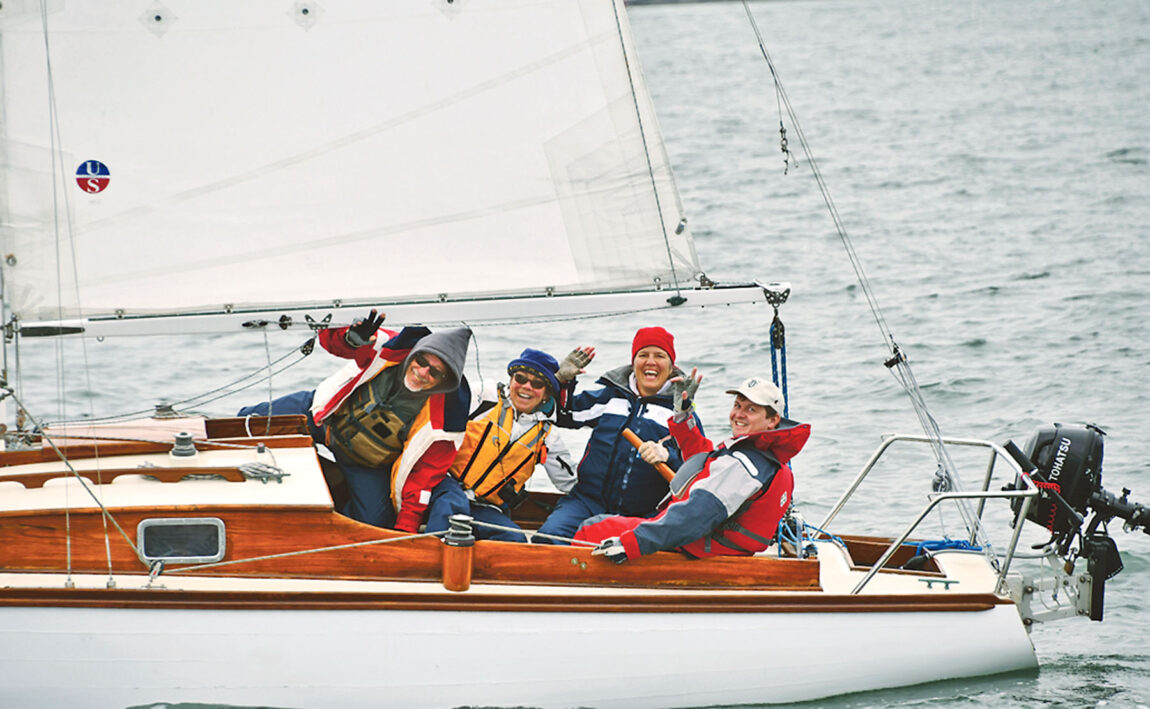
Hear how Liz found her 1956 Japanese-built wooden sloop, why there’s beauty in boat design, how to learn about boats from other enthusiasts, how wooden boats compare to other types of boats, and why anybody can sail.
This episode covers everything from wooden boats to sailing lessons. Here’s a small sample of what you will hear:
- What tall ship did Liz go on?
- How big is her boat?
- Who were her mentors?
- What is the Master Mariners Benevolent Association?
- How long has Liz been a sponsor?
- What events do they host?
- How do you find insurance for wooden boats?
- Short Tacks: Who is Liz’s favorite yacht designer?
Learn more at NorthBeachMarineCanvas.com and SFMasterMariners.org.
Listen to the episode on Apple Podcasts, Spotify, and your other favorite podcast spots — follow and leave a 5-star review if you’re feeling the Good Jibes!
You can support Latitude 38’s local sailing news when you click here.
Visit Vallarta Yacht Club in Banderas Bay
Beached Boat Draws a Crowd Onshore and Online
On Monday we reported that a sailboat, the 28-ft Islander Lorelei, had washed ashore at Baker Beach. We heard the news from Kimball Livingston, who headed down to the beach to see what was going on. At that time there was not much to be learned. The boat’s owner, Chris Escalante, said it was the second time his boat had been adrift, claiming his anchor lines had been cut both times
We weren’t successful in our own efforts to connect with Escalante later that afternoon, but San Francisco’s KTVU News caught the new boatowner at the beach and shared this story on their website: “Owner claims ‘pirates’ pillaged unoccupied sailboat, ship drifts to Baker Beach from Sausalito”
Phil Delano from TowBoatUS San Francisco Bay & Delta was called to assist in removing the boat from the beach.
“It was the second time I’d saved his boat,” Delano told us. Lorelei had been caught on the rocks at Strawberry Point in Richardson Bay on Sunday. As Delano understood at the time, the boat had insurance, its steering was functional, and the owner had told him the motor was working. (SFGate has reported that Lorelei had been “legally anchored in Richardson Bay” prior to coming loose.) The towboat crew took the boat to a self-set mooring. “An anchor with a float,” Delano says.
Escalante said his boat had been cut loose prior to drifting to Strawberry Point. He made this same statement after his boat was found washed ashore on Baker Beach Monday morning.
“This time he got caught in the ebb tide,” Delano says.
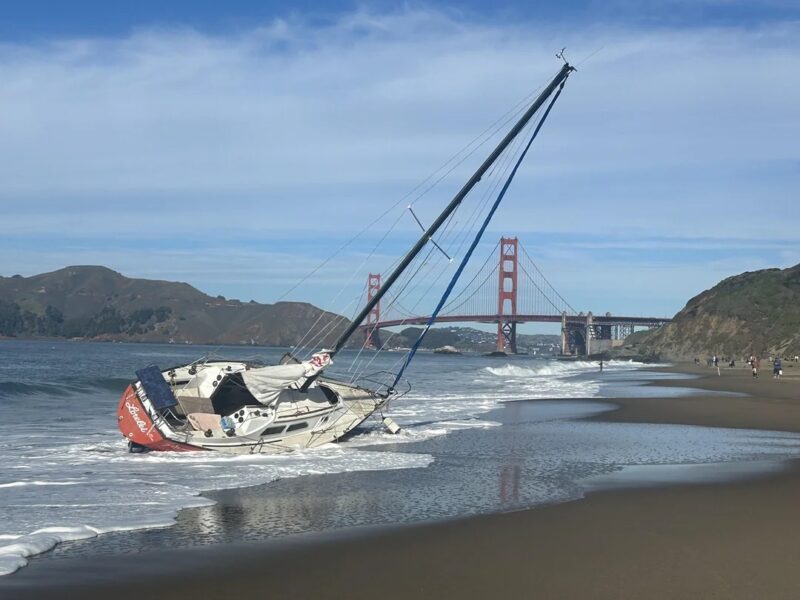
Delano says he was preparing to engage an excavator to dig Lorelei out of the sand and “put it in a box,” saying the 40-year-old boat was in rough shape. But the owner stopped him, hoping to find another way or opportunity to save his vessel, which he has said is also his home.
“There was high surf,” Delano explains. “I didn’t want to risk having a swimmer go out there, climb aboard and set a tow line.”
This now poses the question of “what next?” What will happen when the coming days of rain, tides and gusts churn up the sea and potentially cause the boat to break apart?
We hope it will be removed before that happens. But even if it is removed, where will it end up? Will it be again moored, or anchored, only to come loose again — by whatever means?
Latitude has been advocating for legal mooring fields and legal liveaboards in marinas in the Bay Area for many years. At present there are no legal places to anchor to anchor long-term in the Bay Area. We understand the pull of living on a boat, whether for its simplicity or through necessity. We’re also aware that, at times, a sailor might not be quite fully prepared for the difficulties and realities of living aboard. The Bay has strong currents, and winter brings even more force. It’s often at this time that we hear of boats being washed ashore or pushed up against jetties in the wake of a storm.
In the meantime, the story and photos of Lorelei have gained a lot of attention on news and social media sites. Comments have been shared on our original story on Monday, on Latitude 38’s Instagram account, on Nextdoor — where photos of the boat at Strawberry Point were shared on Sunday, and even on Reddit.
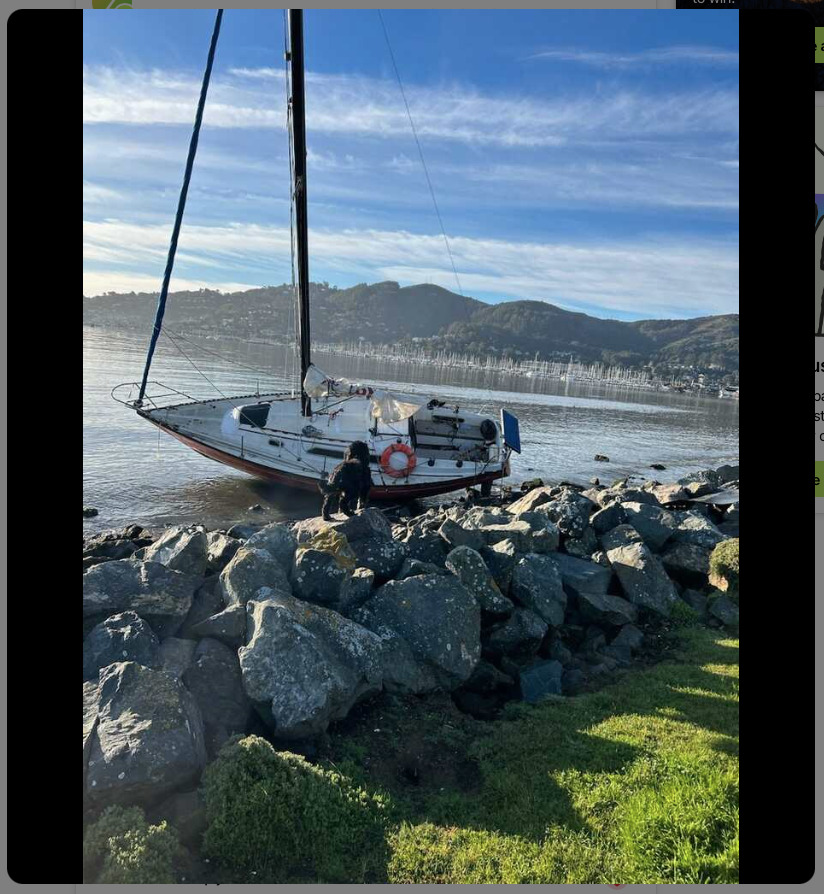
We don’t know the full story behind Lorelei, but we hope that whatever it is, her owner is able to find a way to secure the boat safely and make it through the winter unscathed.
You can support Latitude 38’s local sailing news when you click here.
- Working Waterfront
- General Sailing
- Repair & Maintenance
- Latitude 38 Magazine
- Current News
- Maritime History
Sailor, a Tall Ship and Latitude Connect at The Depot in Mill Valley
Peter Graumann works at the bookstore counter in The Depot Café & Bookstore in Mill Valley. In his spare time he built a tall ship. Actually, he’s been a regular volunteer for the building and maintenance of the Matthew Turner.
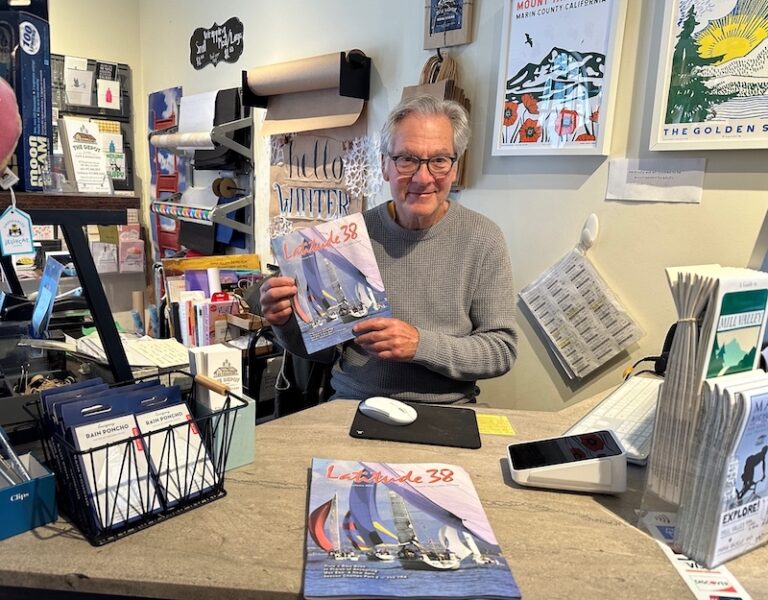
We discovered this as we walked into The Depot, which is one of almost 600 distribution points from Seattle to San Diego where you can pick up a free copy of our print publication. You can find a spot near you on our distribution map here. Enter your zip code to find the store nearest you. If you know of a place frequented by sailors near you that needs to stock Latitude 38, let us know here.
We asked Sylvia Stompe at Call of the Sea (COTS) what Peter has been up to, and she replied, “Peter Graumann has been volunteering with Educational Tall Ship/COTS since early on in the building of the ship. He not only helped with building tasks, he also gave many docent tours of the ship back in the day when demand was very high for groups to tour the building site at the tent. Currently, he is one of the core group of dedicated, Wednesday volunteers who come each week and work on carpentry tasks for both ships (Matthew Turner and Seaward), maintaining the woodwork, restoring cabin sole hatches, and tackling vessel improvements such as building additional storage and designing and building the ‘billboards’ which protect the wooden hull from the anchor. Peter also cheerfully helps keep the workshop clean and organized, a vital but often unsung task!”
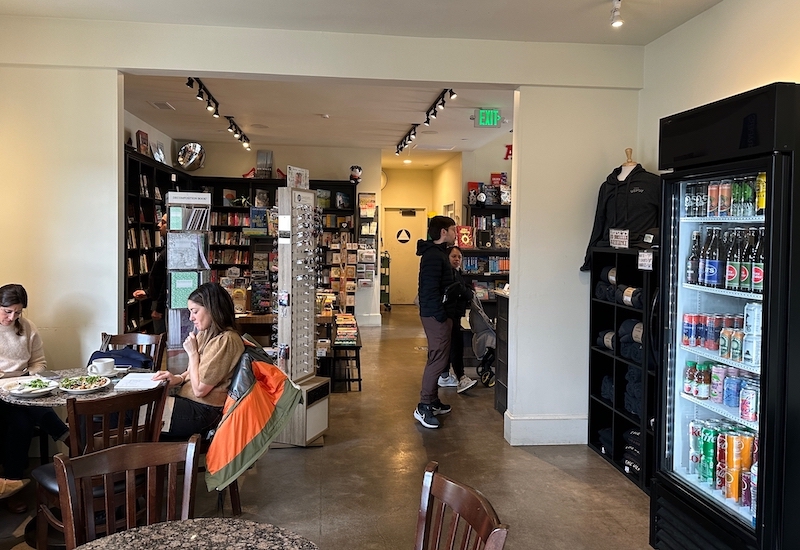
It takes a big crew to sail the Matthew Turner and an even bigger crew to keep her ready to sail. In addition to Peter’s work volunteering for Call of the Sea, we’re happy to have a sailor on hand to make sure Latitude 38 gets into the hands of fellow sailors who want to read about the adventures of California sailors.
Also, thanks to The Depot Café & Bookstore and all our distributors who help bring the magazine to you.

